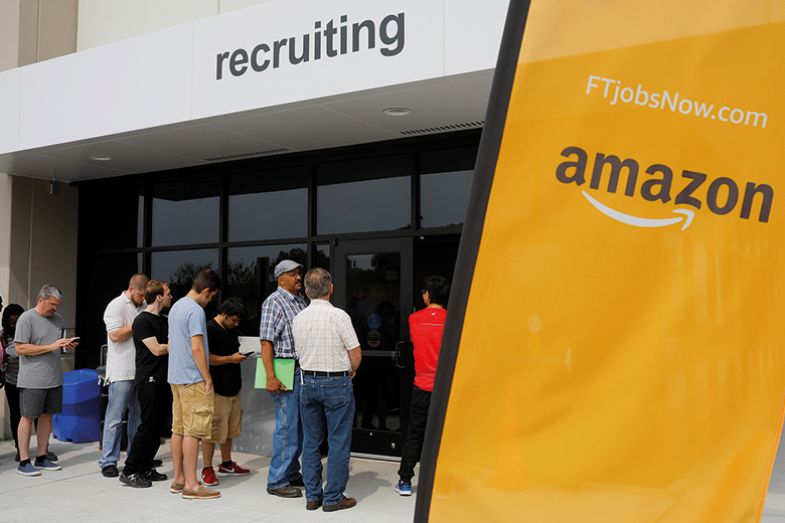From his office in a former mill complex, where cotton from enslaved Americans was processed into textiles two centuries ago, Southern New Hampshire University president Paul LeBlanc has the perfect view of an unlikely monument to the breakneck transformation of US higher education. And this was one that even he, one of its most respected innovators, could not have anticipated.
Nearly two decades into transforming the Manchester, New Hampshire-based institution from a struggling regional private institution to a 135,000-student online behemoth, LeBlanc finally gave in to his mushrooming workforce and built them a six-storey, 1,700-space parking garage.
Almost immediately after its completion, Covid hit. During the first 12 months of the pandemic, LeBlanc watched his enrolment jump by 40,000 students, and he hired 1,000 more full-time staff to support them. But, of course, everyone was working from home. And even with the pandemic now easing, 300 parking spaces is plenty of capacity most days. It’s a new reality, not expected to reverse.
“If you want to buy a slightly used parking garage – only slightly broken in – I have a deal for you,” LeBlanc says, a little sheepishly. “It’s the way the world has changed.”

When Covid shuttered the world in March 2020, two things quickly became clear for higher education. One was that online teaching was about to get a major tryout. The other was that universities that were already struggling financially were about to see their plight get a lot worse.
But now, as Covid finally seems manageable without major social restrictions, an arguably more fundamental challenge has emerged: a huge and somewhat inexplicable wave of labour volatility. Workers throughout the US economy, and especially those who endured the pandemic in face-to-face service positions, appear to be suddenly quitting, in what has become known as the Great Resignation. And those staying are feeling empowered to make fundamental new demands about their pay, their remote working options and their overall work-life balance.
From a number of directions, that is having major, attention-demanding effects across higher education. Institutions have suddenly found themselves fighting to attract and keep their own professional workforces. They are also grappling with how to adjust their teaching and pastoral provision in line with students’ dramatically altered life circumstances and career expectations.
Meanwhile, new levels of complication are being introduced to many of the big challenges that pre-date Covid, such as how to truly serve older students, offer real-world job experience and outsource peripheral campus functions.
“It’s a complex witches’ brew,” says Cole Clark, managing director for higher education at the consulting firm Deloitte Services, of the sudden disruption of labour equilibrium in the academy. “It’s a huge problem for everyone we’ve talked to.”

While the hyper-demand for academic jobs may prevent most faculty from joining the Great Resignation, there are some exceptions. Computer science academics have long been targets for technology firms, for instance, but efforts to lure them are intensifying. And it isn’t only computer scientists that the firms want. Amazon is now hiring more economists than the Federal Reserve Board, according to Bledi Taska, chief economist at labour market analytics firm Emsi Burning Glass. “We are seeing significant reallocations” of academic economists to private industry, he says.
Moreover, staff in professional and support roles are very much part of the post-Covid workforce volatility. Colleges and universities are facing unrelenting competition for staff from a variety of other industries. For example, restaurants are luring away food-service workers – leaving bare-bones dining halls on many US campuses. And one recent survey of top US research universities, Clark says, found half of them with interim appointees serving as their chief human resource officers.
“It’s really shocking how much change there has been,” Clark says.
Job vacancies are so widespread that Bridget Burns, executive director of the University Innovation Alliance – a solutions-focused coalition of public research universities – sees them as “the biggest threat to student success right now”.
And yet, the national labour uprising also brings real hope of a more sustainable future for much of US higher education, after years of rising costs, shrinking enrolments and fears of cascading institutional collapses.
The biggest potential positive shift is the raft of major US corporations jumping to embrace postsecondary training as never before – potentially making this tax-advantaged but long-overlooked benefit as fundamental to employee life as healthcare and retirement saving plans. Major employers, including Amazon – as well as Walmart, Starbucks and the home improvement chain Home Depot – appear to have realised that the best way to find good workers in a tough hiring environment is to train up the ones they already have. They are not just offering tuition benefits but are actively creating systems to help their workers take advantage of them.
The beneficiaries in higher education are largely those with online operations. They range in size from LeBlanc’s giant SNHU down to the three-campus National University – which currently has 40,000 students, but openly dreams of attracting just a slice of Amazon’s 750,000 workers.
“We’re hoping that we can help serve that population, and more,” says the university’s vice-chancellor of strategy and innovation, Michelle Weise.
That is already a reality at SNHU, where corporate partners have quickly become a major driver of enrolment. Even before its Amazon partnership was formally announced in March, LeBlanc says, 2,500 of the global conglomerate’s employees discovered the SNHU option on their own, and signed up for classes within a few weeks.
The rest of traditional US higher education – to the degree that such a concept still exists – may not be far behind. The online experience during Covid was widely panned by students and faculty alike, but, with time, US campus leaders have realised that online teaching is about much more than low-quality Zoom links, and that virtual options will need to be permanent for many classes.
It is now becoming clear that hostility to online teaching wasn’t even primarily about its quality, LeBlanc says. Instead, it mostly reflected the fact that students were missing their in-person campus communities. “One of the revelations of the pandemic,” he says, “was that students grieved, mourned for that more than they grieved the absence of in-person classrooms.”

An emerging bellwether for the future of online provision, after years of hype and uncertainty, is Pennsylvania. As elsewhere, balancing tuition and staffing is critical to the state’s colleges and universities, with labour costs accounting for about 75 per cent of total expenditures. But Pennsylvania has one of the oldest populations in the US and one of the nation’s fastest-declining rates of high-school enrolment. For that reason, its campuses are reaching the point where they are able to sustain only perhaps 40 academic programmes, according to the state’s chancellor of higher education, Daniel Greenstein, seriously limiting students’ options.
“Those challenges are not unique” to Pennsylvania, Greenstein says. But “they’re super-acute here”.
The labour market does present Pennsylvania with an upside. Just as the state finds itself with a potential excess of higher education capacity, it is seeing that 60 per cent of its jobs require some level of postsecondary education, with only half of the population so far fitting that bill. And when graduate jobs are largely the highest paying, demand for them seems bound to keep feeding into college enrolments.
“We can debate forever about the gestalt of higher education,” Greenstein says. “But I can demonstrate, measurably, that those of our students with a degree get about $850,000 in higher lifetime earnings than someone without.” In that sense, “in some ways, our oversupply of capacity is a good thing,” Greenstein says. “It’s just that we’ve got to point it in different places.”
To that end, Greenstein has consolidated six of Pennsylvania’s public colleges in rural areas into two accredited units. Online links between them will allow students to access courses they need for their degrees that aren’t available in their particular physical location.
This is not as shocking a move as some in US higher education might imagine, Greenstein says, since most of Pennsylvania’s public university students were already taking at least one course online every term even before Covid. Yet it was still a needlessly difficult transition, according to Clark and other experts. Pennsylvania’s consolidations required state legislative approval, in what Clark sees as a reflection of the politics and inertia that often protect local administrators and the overbuilt nature of US higher education. In too many states, Clark says, public university systems are “unable to really make significant moves, and so they have to operate through influence”. Pennsylvania, he says, “is an example of just how bad things have to get before you finally see change”.

Another clear sign of labour-related stress is found at community colleges, which specialise in two-year associate degrees aligned with local workforce needs. Their enrolments have been hit the hardest of all postsecondary sectors, dropping some 15 per cent during Covid and not recovering since. The reasons aren’t entirely clear but almost certainly reflect the tougher life conditions facing their usual customers in the least-advantaged sectors of US society – and the corresponding difficulty those students face in attending in-person classes.
Indeed, one of the most enduring effects of the pandemic on US higher education, according to the University Innovation Alliance’s Burns, may be the unflinching view it has provided of the everyday lives of the nation’s most disadvantaged students, many of whom were furloughed or made unemployed during the pandemic. That insight makes clear, she says, that colleges and universities outside the elites must solve the student affordability challenge to stay viable. And the flexibility provided by online formats absolutely must be a central element. “The truth”, she says, “is that there is no possible future in which digital learning is not an embedded aspect of higher ed.”
That acknowledgement reflects the ongoing hunt in much of US higher education for the factors that cause struggling students to drop out. One result on some campuses is the modest allocations of emergency funds to help students when unexpected expenses, such as a medical or car repair bill, might make the difference between finishing a degree and dropping out.
A larger-scale response to the affordability question is the University of the People, a largely free yet accredited online provider that’s grown to 117,000 students in just over 10 years, negotiating credit-transfer arrangements with divisions of traditional heavyweights, such as Harvard and New York universities, along the way.
Its exact model isn’t going to be widely replicated, its founder and president, Shai Reshef, readily concedes. Its faculty aren’t paid, and the courses are a limited menu of job-centric classics, including business administration, computer science and health services. The main undergraduate charge is a $120 assessment fee for each completed course.
The venture does, however, offer some important pointers for the rest of higher education on how to find students in new places, Reshef argues, rather than squabbling over the existing market.
“More aggressive marketing doesn’t work when the market is shrinking,” he says. “The question is, ‘How do I make my education more affordable?’ rather than, ‘How do I steal more students from other universities?’” Its ultra-low-cost approach sees the University of the People serving everyone from homeless people in the US to African street fruit vendors and women hiding from Taliban restrictions in Afghanistan.
For students of more middle-American backgrounds, better job training may require fighting 21st-century attention spans. One innovator in that space, Aaron Rasmussen, created MasterClass, an entertaining collection of online lessons starring celebrity hosts. He is now heading a more academic-oriented version called Outlier.org, featuring traditional subjects such as mathematics, astronomy, psychology and accounting, but in slick Hollywood-style productions led by professors known for charismatic and engaging delivery styles.
The “casting” process, Rasmussen says, involved sifting through 200 instructors before finding the right fit. Outlier.org also pays heavy attention to research on technology’s effectiveness, in areas such as course management. It, too, has Amazon among its early customers.
“It turns out these techniques, which are all evidence-based, really do work well,” Rasmussen says.
Yet for many of the challenges facing universities heading towards a post-Covid but labour-disrupted world, evidence for the effectiveness of digital solutions largely doesn’t exist. Burns, for instance, recently met with a group of university academic advisers and heard stories of students coming into their offices crying about problems they were facing. “But they never once had the experience of a student getting to that space of vulnerability on Zoom,” she says. “So the question is, what are people holding back, because of the digital experience, that denies them the benefit of a service that they need? And I don’t think we know that enough.”

Universities face similar evidence shortfalls in handling their own post-pandemic staffing dilemmas. At SNHU, LeBlanc is determined to let his employees work remotely as much as possible. That, after all, is now one of the first things prospective new employees ask about. “We will never go back to the kind of rigid, you-have-to-be-in-the-office-these-hours sorts of models – that’s gone,” he says.
But he knows there are downsides to that decision. The Great Resignation has combined with homeworking to disperse much of the youthful, mission-focused excitement and camaraderie that marked his office prior to the pandemic. And everyday acts of on-the-job learning – such as a young staffer fielding a student’s phone call, then swivelling his chair for a quick word of advice from a more experienced colleague – are getting lost.
It was growing apparent even before the pandemic, says National University’s Weise, that institutions need updated perspectives on their workplace environments. “We just weren’t feeling the pain quite then as much as we are right now”, amid fatigue over low pay and the rise of a “you-only-live-once mentality”, she says.
At the National University System, Weise hopes that artificial intelligence interfaces can help institutions ease the career-related challenges of their workers and students. The tool, gaining acceptance in some private companies, amounts to an online questionnaire that asks people about their current life skills and future ambitions and maps out the educational components necessary to get there. For too many workers in universities and beyond, she says, it has not been “100 per cent clear about how you move up or how you progress” professionally.
Burns sees much the same thing. “The design of work has to change in higher ed,” she says. Institutions have long given their workers the idea that they will move up the career ladder only after they have “put in their 20 years”, she says. “And people are tired of that” – especially after working highly demanding jobs in student services that require 24/7 attention.
However, much of higher education, Burns says, doesn’t have the internal expertise to tackle such challenges. Universities need outside help, but they are “terrified of failure”. Hence, even though the pandemic showed academia that it can transform much faster than it might have believed, “we hide [challenges] under the carpet”, prolonging dysfunction.
Deloitte’s Clark agrees, noting that too many administrators are trying short-term fixes for their labour woes, such as poaching remote workers from elsewhere. That is great for some people, Clark says, such as an information services expert who lands a West coast job that lets her remain in her low-cost rural community back east. But too many universities aren’t accepting the need for meaningful adaptions, he adds. For instance, “most of them have never experimented with any kind of flexible work model”, he notes.
Some institutions are prevented by state rules from competing in that sphere. Others, Reshef says, may bend to worker preferences without taking enough care to maintain the uniqueness and value of their long-established ways of working. “If you take this too far, you could really do some significant damage to the culture of the place,” he says. “There’s a lot of disruption ahead on this front, and it hasn’t played out fully yet.”
Interpreting higher education’s labour shifts is complicated by the millions of human interactions that feed into them, of course. And there is certainly a school of thought that US workers are just having a moment – and that more normal patterns of behaviour will resume shortly. But LeBlanc, for one, is not expecting his investment in that car park to be justified any time soon. He expects further evolution in working practice – though with limits. He notes that the computing giant IBM tried fully remote operations years ago, before backpedalling. He is asking his staff to find the lessons in such examples in order to point their own way forwards.
“Like everyone else, we’ll figure this out,” LeBlanc promises. But he has no intention of acting like previous bosses of SNHU’s historic premises and policing presenteeism with an iron fist. “There’s no delusion that we’re going to somehow have everyone back in the mill complex again,” he confirms.
Parking attendants who joined the Great Resignation to take a job at Manchester’s shiny new multistorey may find that they have time to pursue an online degree in between eyeballing the occasional vehicles to pass their booths.
Register to continue
Why register?
- Registration is free and only takes a moment
- Once registered, you can read 3 articles a month
- Sign up for our newsletter
Subscribe
Or subscribe for unlimited access to:
- Unlimited access to news, views, insights & reviews
- Digital editions
- Digital access to THE’s university and college rankings analysis
Already registered or a current subscriber? Login








